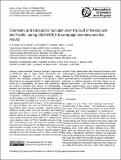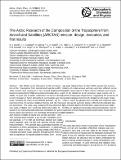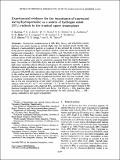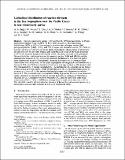Search
Now showing items 1-10 of 17
Chemistry and Transport of Pollution over the Gulf of Mexico and the Pacific: Spring 2006 INTEX-B Campaign Overview and First Results
(European Geosciences Union, 2009)
Intercontinental Chemical Transport Experiment-B (INTEX-B) was a major NASA (Acronyms are provided in Appendix A.) led multi-partner atmospheric field campaign completed in the spring of 2006 (http://cloud1.arc.nasa.gov/intex-b/). ...
The Arctic Research of the Composition of the Troposphere from Aircraft and Satellites (ARCTAS) Mission: Design, Execution, and First Results
(European Geosciences Union, 2010)
The NASA Arctic Research of the Composition of the Troposphere from Aircraft and Satellites (ARCTAS) mission was conducted in two 3-week deployments based in Alaska (April 2008) and western Canada (June–July 2008). Its ...
Overview of the Summer 2004 Intercontinental Chemical Transport Experiment–North America (INTEX-A)
(American Geophysical Union, 2006)
The INTEX-A field mission was conducted in the summer of 2004 (1 July to 15 August 2004) over North America (NA) and the Atlantic in cooperation with multiple national and international partners as part of a consortium ...
Surface and Lightning Sources of Nitrogen Oxides over the United States: Magnitudes, Chemical Evolution, and Outflow
(American Geophysical Union, 2007)
We use observations from two aircraft during the ICARTT campaign over the eastern United States and North Atlantic during summer 2004, interpreted with a global 3-D model of tropospheric chemistry (GEOS-Chem) to test current ...
Experimental evidence for the importance of convected methylhydroperoxide as a source of hydrogen oxide (HO x ) radicals in the tropical upper troposphere
(Wiley-Blackwell, 2001)
Concurrent measurements of OH, HO2, H2O2, and CH3OOH concentrations were made during an aircraft flight over the tropical South Pacific that followed a back-and-forth pattern at constant 10 km altitude for 4 hours. One end ...
In situ measurements of HCN and CH3CN over the Pacific Ocean: Sources, sinks, and budgets
(Wiley-Blackwell, 2003)
We report the first in situ measurements of hydrogen cyanide (HCN) and methyl cyanide (CH3CN, acetonitrile) from the Pacific troposphere (0–12 km) obtained during the NASA Transport and Chemical Evolution over the Pacific ...
Atmospheric chemistry in the Arctic and subarctic: Influence of natural fires, industrial emissions, and stratospheric inputs
(Wiley-Blackwell, 1992)
Haze layers with perturbed concentrations of trace gases, believed to originate from tundra and forest wild fires, were observed over extensive areas of Alaska and Canada in 1988. Enhancements of CH, CH, CH, CH, and CH ...
Summertime photochemistry of the troposphere at high northern latitudes
(Wiley-Blackwell, 1992)
The budgets of O, NO (NO+NO), reactive nitrogen (NO), and acetic acid in the 0–6 km column over western Alaska in summer are examined by photochemical modeling of aircraft and ground‐based measurements from the Arctic ...
Origin of ozone and NO x in the tropical troposphere: A photochemical analysis of aircraft observations over the South Atlantic basin
(Wiley-Blackwell, 1996)
The photochemistry of the troposphere over the South Atlantic basin is examined by modeling of aircraft observations up to 12-km altitude taken during the TRACE A expedition in September–October 1992. A close balance is ...
Latitudinal distribution of reactive nitrogen in the free troposphere over the Pacific Ocean in late winter/early spring
(Wiley-Blackwell, 1998)
The late winter/early spring (February/March, 1994) measurements of Pacific Exploratory Mission-West (PEM-W) B have been analyzed to show latitudinal distributions (45°N to 10°S) of the mixing ratios of reactive nitrogen ...











